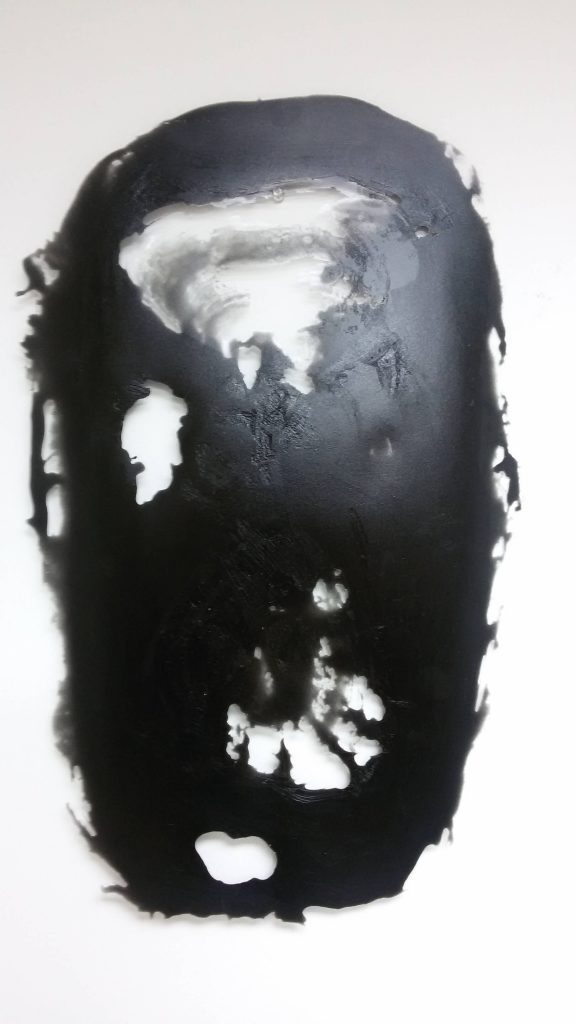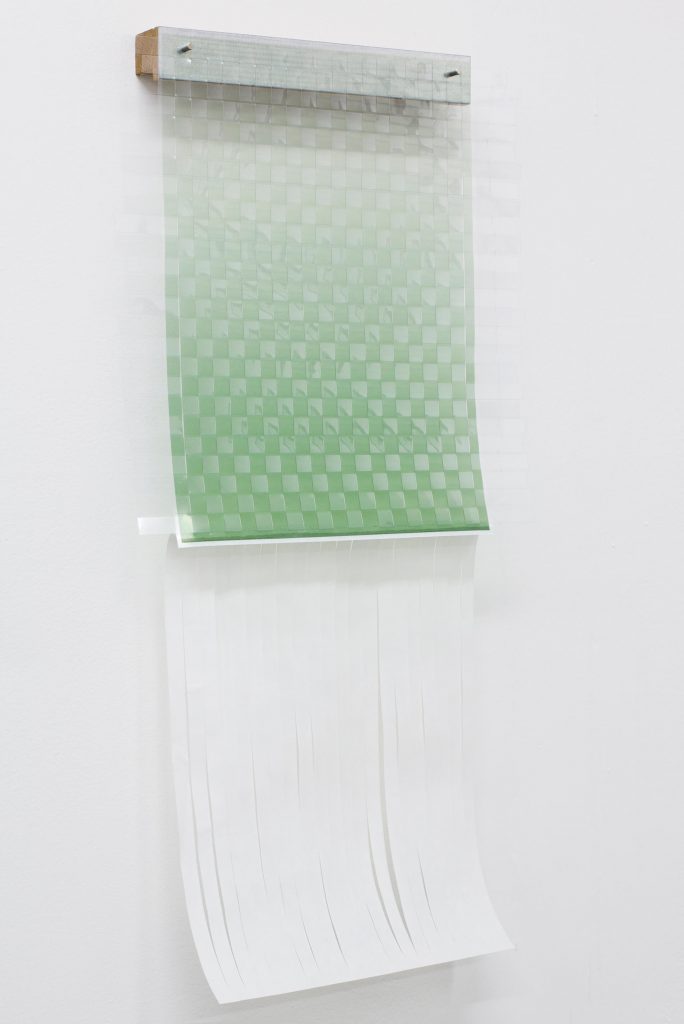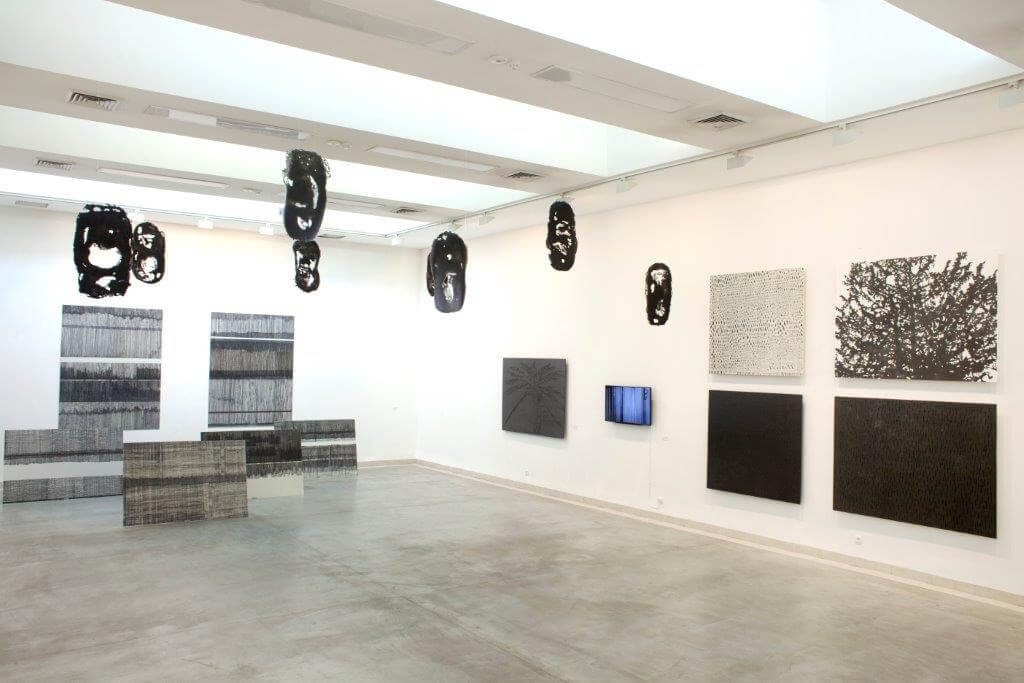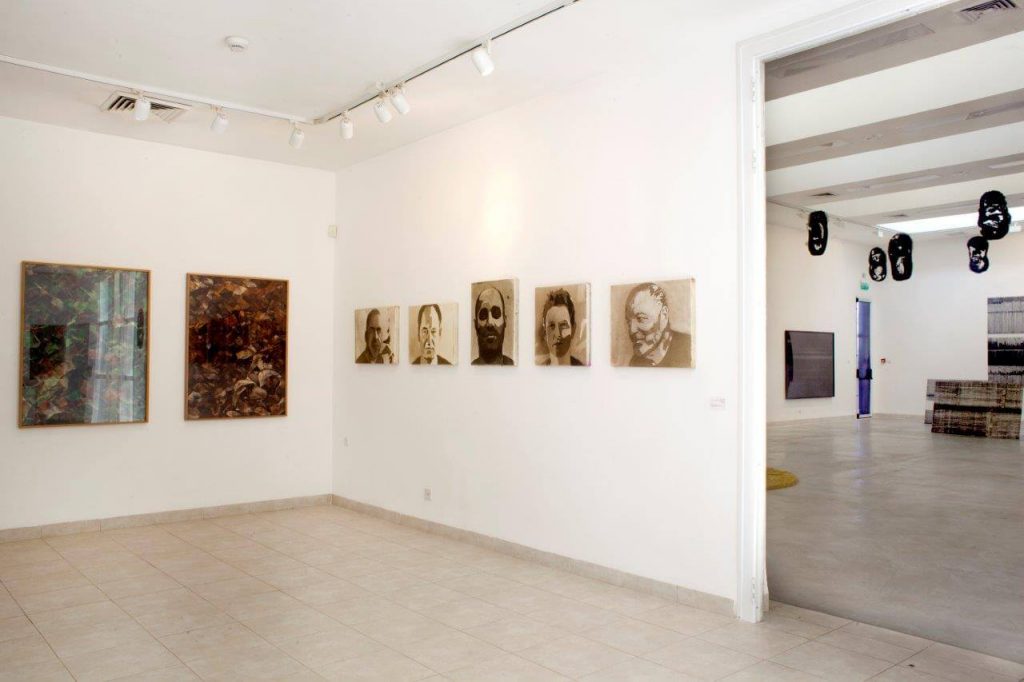Monochrome
January 2016
Kupferman’s studio is an inseparable part of the gallery. Its door is open, and visitors are invited to enter and view the easel, pencil, graphite, eraser bits, paintbrushes and trowels, which seem to still carry the imprint of his hand. The exhibition Monochrome centers on some of the qualities, intentions, abilities, and actions embodied by Kupferman, the artist and the man.
According to its dictionary definition, a “monochrome,” is an object or artwork that is painted different shades of a single color. Some online entries even describe it as boring and monotonous. The ascetic use that Kupferman and the artists included in this exhibition make of an intentionally restricted range of colors attests to a demanding, in-depth research process.
As Yona Fischer writes In the exhibition catalogue Moshe Kupferman, Works from 1962 to 2000 (The Israel Museum, 2002): “Kupferman is the rememberer, body and soul; he is the Kupferman of the arm that remembers its gestures, of the violet that remembers alternately its gray and its red components; he is the Kupferman who reiterates things as if to revalidate their ‘justification’ – and all these things join the unceasing forward-backward sequence, the rhythm of activities performed on the canvas or paper. This forward-backward sequence is the core and essence of the Kupfermanian rhythm; it is also potentially a metaphor for a fraught dialogue between the past and the present.”
The artists participating in the current exhibition – Rubi Bakal, Dan Bergstein, Neta Cones, Nir Evron, Guy Goldstein, Michal Helfman, Orit Ishay, Gabi Klezmer, Matan Mittwoch, Zaudito Yosef Seri, and Gal Weinstein – intensify the insistence on chromatic restraint, the pulsating rhythm, and the in-depth engagement typical of Kupferman’s work. Two of the materials used by a number of these artists are also related to the surprising and exciting discovery of graphene, which I learned about in one of my conversations with Guy Goldstein in preparation for this exhibition. This revolutionary chemical substance, which seems to be the thinnest material in existence, is also incredibly strong and light. Graphene was discovered by Andre Geim and Konstantin Novoselova, two Russian scientists from the University of Manchester who received the Nobel Prize for its study and development. Its existence was first revealed when they removed strips of sticky tape from a surface composed of the mineral graphite – the same graphite, and perhaps the same sticky tape, used by Kupferman, Guy Goldstein, Dan Bergstein, Rubi Bakal, and other artists. The use of these materials, which is discussed below, thus creates an encounter between art and a fascinating scientific discovery.
Zaudito Yosef Seri goes to the supermarket to buy barbecue charcoal. Back in her kitchen, she grinds it in a coffee grinder to create charcoal dust – a material that determines the color of her works and embodies the meaning of her artistic practice. “Self,” the series of reliefs she created over the past year, resembles African masks. Combining intentional and randomly created processes, she mixed the charcoal dust with various types of glue in her home laboratory, giving rise to a simultaneous chemical reaction of attraction and repulsion. The materials adhere to one another, yet refuse to become a single amalgam – thus forming the array of shapes appearing on the reliefs. These actions are performed as if they were part of a ritual ceremony in which the artist removes a layer of skin, a cloak that seems to have enveloped her body following an act of sorcery.
Neta Cones returned from a trip to Zanzibar with a touching photograph: young coconut groves protected from animals by a fence woven out of dry coconut leaves, which ensconce the young plant in a structure resembling local houses.
The chromatic makeup of the photograph was analyzed in a laborious process of weaving, which reconstructed the process of weaving the leaves by interweaving strips of laminated transparencies with paper colored to resemble the shades of the living and dead parts of the coconut plant. This idea was inspired by the colors used to represent different materials on architectural plans – amounting to a sort of formal encoding and technical detailing of a memory and experience, which fan out to form a sensual display.
Rubi Bakal draws in dust. After carefully planning his work process, he creates portraits of different artists using layers of tape that are applied to a canvas. He then lays each canvas in a forgotten corner of the portrayed artist’s studio, where it accumulates a layer of atmospheric dust along with the surrounding energies, dead skin cells, fibers released from clothes and textiles, smells and sounds.
Every few weeks, at set intervals, Bakal returns to the studio, removes the layer of tape, and exposes the canvas, leaving it to accumulate another layer of dust. The gradual removal of the strips of tape determines the different shades of the painting; the lighter areas, which have yet to accumulate enough dust, mark the end of the process.
Guy Goldstein‘s works are part of a wide-ranging project concerned with the term “noise colors.” This series centers on an attempt to study and understand gray noise, whose frequencies carry a minimal amount of energy (as opposed to white noise, whose frequencies are all equally intense in terms of their vibrations, encompassing the entire spectrum of sounds – much like white light encompasses the entire spectrum of colors). These works were created using drills, whose bits were replaced by graphite and pencils. Goldstein then drills into a paper surface to produce drawings and serpentine textures. He subsequently “records” his work by using sticky tape to collect the excess graphite from the paper, and piles layers of tape strips onto a Dibond surface. This process of editing raw materials, and of transporting a substance from one location to another, creates a rich chromatic effect, transforming the non-descript gray surface into a tangle of colorful, rhythmically pulsating shades of gray.
Nir Evron‘s series of photographs, “Composite,” captures military camouflage nets that were cut up, piled onto a scanner, and manipulated to strip them of their secretive military character. Like the term “camouflage net,” which may describe an attempt to cover up for one’s true intentions, this artistic action attempts to conceal its origin and blur it to the point of creating a new semblance of “truth.”
Gabi Klezmer‘s 2005 video work Assassin was created as part of his exhibition “Assassins,” which was featured at the Herzliya Museum of Contemporary Art in 2002. The exhibition included three paintings – wide, continuous, horizontal black stripes – which were each exhibited on a separate wall. These large-scale paintings (15×5 meters each) were created by sweeping a rubber wiper once across the gallery floor, with expansive and decisive hand and body gestures. At the center of the gallery was a rotating stage that enabled visitors to observe the paintings as if participating in the process of scanning them. In this video work, the artist performs various actions in the gallery in order to exemplify the viewer’s experience of moving through the exhibition space as it is transformed into an arena of action.
Orit Ishay‘s video work Up (2015), which was created during her participation in a residency program in Vienna, captures the entrails of an elevator. The moving cables participate in a dramatic choreography of mesmerizing, endless movement, which gives rise to a sense of entrapment and of an impending loss.
In 2005, Gal Weinstein presented the installation The Hula Valley at the Tel Aviv Museum of Art’s Helena Rubinstein Pavilion. This floor work, which was featured in the building’s lobby, resembled the cracked surface of the dry lake. It was made out of MDF boards that were carved, sawed, injured and manipulated to form a perfect image of the fissured clay expanse.
Weinstein’s series “Sealing Gaps,” which is included in this exhibition, is composed of parts of this earlier work. Weinstein has now sealed the cracks in what amounts to a therapeutic process, an attempt at restoration and healing. Yet this process fails demonstrably: the coating only serves to underscore the previously existing state of devastation. The scars have become even more painful, as their presence takes center stage to form a new painting.
Michal Helfman‘s floor installation Territories (2013-2016) is a nostalgic rendition of a children’s game by this name. In this game, which is played upon a large, flat expanse of earth, a knife is the only tool. After it is used to circumscribe a large circle, two players stand outside the circle, and one of them throws the knife into the circle so that it is vertically inserted into the earth. The player then draws a straight line from the location of the knife to the circumference of the circle, thus bisecting the circle into two areas. The smaller area becomes his or her territory, while the rest of the circle now belongs to the opponent. The moment he has “conquered” a territory, the player steps into it and once again attempts to cast the knife into enemy territory. Each time he manages to do so and draw a line, he annexes the smaller part of the remaining area. As the knife is thrown again and again and the battle unfolds, the atmosphere intensifies, finally leading to the conquest of one opponent and to the occupation of the other opponent’s territory.
Matan Mittwoch‘s series “Waves” (2015) features three studio photographs that simulate events at once romantic and concrete – a sunset, twilight, and nighttime. Each of these events is staged in typical monochromatic shades by means of a found material (corrugated cardboard) and lighting. A horizon line bisects each of the photographs, unifying them by means of a pulsating universal rhythm.
Dan Bergstein‘s work – wooden boards reminiscent of school desks – was inspired by his own youthful creations. Bergstein labored to cover these desks, which had witnessed generations of students and were filled with scribbles disclosing the names of first loves, admired pop bands, and more, with countless layers of graphite and markers. The resulting grid expresses the tension between stability and frenetic activity, the need for constant movement and a Sisyphean, monochromatic action that fills the dead hours and the desire to break free and access the natural world outside. The endless layers of black graphite, combined with the calligraphic strokes of the markers, began casting their own shadow. Consciously limiting himself to the most readily available and basic materials, the artist employed restraint, simplicity, and monotony, with slight variations on the structure and process of repetition, to create a dense, percolating, tremulous surface.
These tightly assembled surfaces, which were first exhibited at the Herzliya Museum in 2001, evolved over the years into landscape paintings combining the natural expanse in which Dan rode his bike as an outstanding athlete and the work of art unfolding in the studio. A treetop glimpsed in the course of a race was transformed into a painting formed out of slow pencil strokes over the course of many weeks with an uncompromising authority, giving rise to a Zen work, a pulsating painting.
Dan Bergstein ended his life in his studio in June 2015.
Curator and author: Dalia Levin
Text on the work of Dan Bergstein: Arik Miranda






